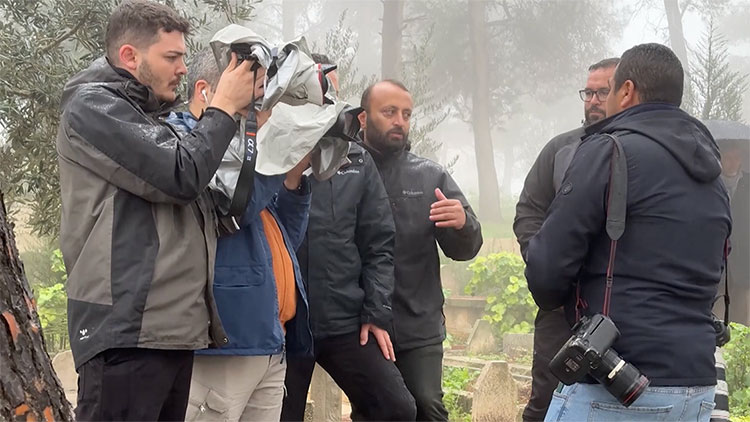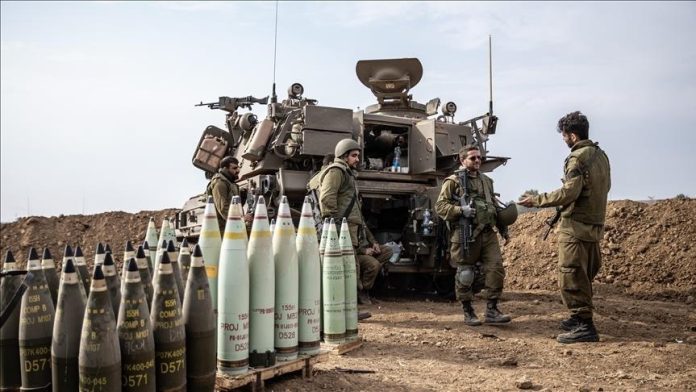16 January 2024
Among the evidence presented in the “genocide” case filed against Israel at the International Court of Justice (ICJ), images from Anadolu are included. A book titled “Evidence,” containing these images that expose Israel’s crimes in Gaza, has been published. Now, a documentary is being prepared to shed light on the challenges faced by the journalists who procured the evidence for this book.

During the documentary shoot, Anadolu reporter Serkan Kaya, along with cameramen Alican Ocak and Muhammed Yasar Kordemirci, visited East Jerusalem and the West Bank under occupation, and observed the work of local journalists, conducted interviews, and documented their experiences.
Unable to enter Gaza due to Israel’s restrictions on journalists, the team plans to record the testimonies of Anadolu employees in Gaza separately and incorporate them into the documentary.
Highlighting that the world has turned a blind eye and deaf ear to the atrocities in Gaza for over 100 days, Kaya stated that it was the work of Anadolu that exposed these events to the world.
Kaya emphasized that the real evidence depicting the magnitude of the tragedy lies in the visuals captured by photojournalists and camera persons, revealing how the world learned about the use of white phosphorus through Anadolu, the rescue of children from building debris, artillery firings, and the oppression of Israeli civilians against Muslims and journalists.
He said: “The world learned through Anadolu Agency how white phosphorus was used by Israel. It saw with Anadolu Agency’s footage how children were rescued from the wreckage of buildings.”
“It learned through the efforts of journalists how artillery was fired and how Israeli civilians armed themselves, pressuring Muslims and journalists,” he stated.
“Witnessing and capturing the events, the testimonies of both Anadolu Agency and other Turkish media workers who were there are essential. That’s why we decided to make this documentary,” he said.
Kaya expressed his appreciation for the dedication and sacrifices of the Anadolu team working in Gaza, the West Bank, and Jerusalem during this challenging period.
Something hidden in Gaza
While covering the funeral of a Palestinian killed by Israeli forces in the occupied West Bank, Kaya witnessed people raising their hands as a parting tribute and Anadolu cameraman Hisham Abu Shaqra lifting his camera.
Kaya recounted: “When I asked why he did that, he replied, ‘My weapon is my camera,’ stating that he never considered quitting his job, documenting everything, and never fearing death. That was the most important thing that stuck in my mind.”
Kaya interpreted Israel’s refusal to allow any journalists into the Gaza Strip as: “Apparently, something undesirable is happening there.”
Momentary joy in a photograph, giving way to sorrow
Anadolu cameraman Alican Ocak mentioned the opportunity to interview individuals who produced materials used as evidence in international courts.
Observing the Anadolu team’s remarkable work in the region within a short period and under difficult conditions, Ocak said: “It is really difficult to narrate what Israel did from Israel’s perspective. I understood that.”
Ocak shared that the most impactful interview for him was with Anadolu photojournalist Mustafa Alkharouf, who captured a photograph of white phosphorus that was presented as evidence in the genocide case against Israel in The Hague.
He said: “Alkharouf initially felt joy when he took that photo, but when he thought that those bombs in the photo would be dropped on the people of Gaza, his joy turned into horror, and he was deeply saddened. That had a profound impact on me.”
Anadolu cameraman Muhammed Yasar Kordemirci, who spent a week working with journalists featured in the “Evidence” book, stated that he witnessed the difficulties of working in the region firsthand.
Kordemirci said he saw Israeli police interfering with journalists on the ground.
He said: “I witnessed the Israeli police intervening in the situation they called an ‘incident,’ as well as separate police teams interfering with the press. I witnessed the colleagues who contributed to the ‘Evidence’ book. I saw the difficult conditions they worked under.”




